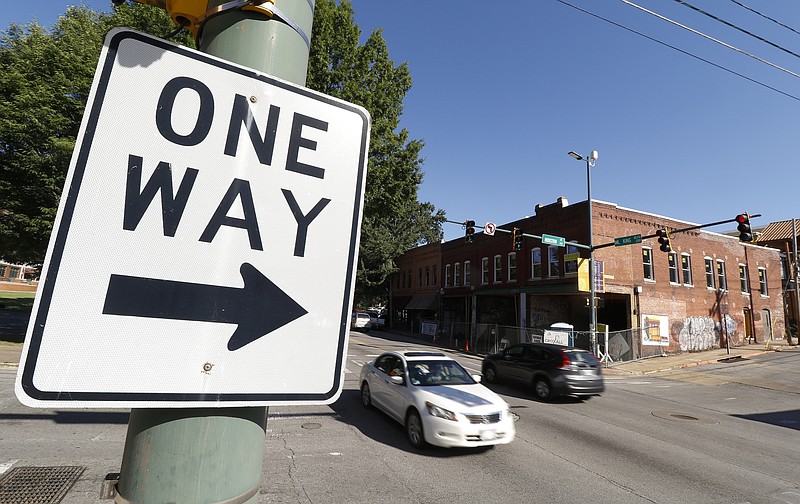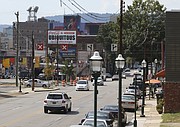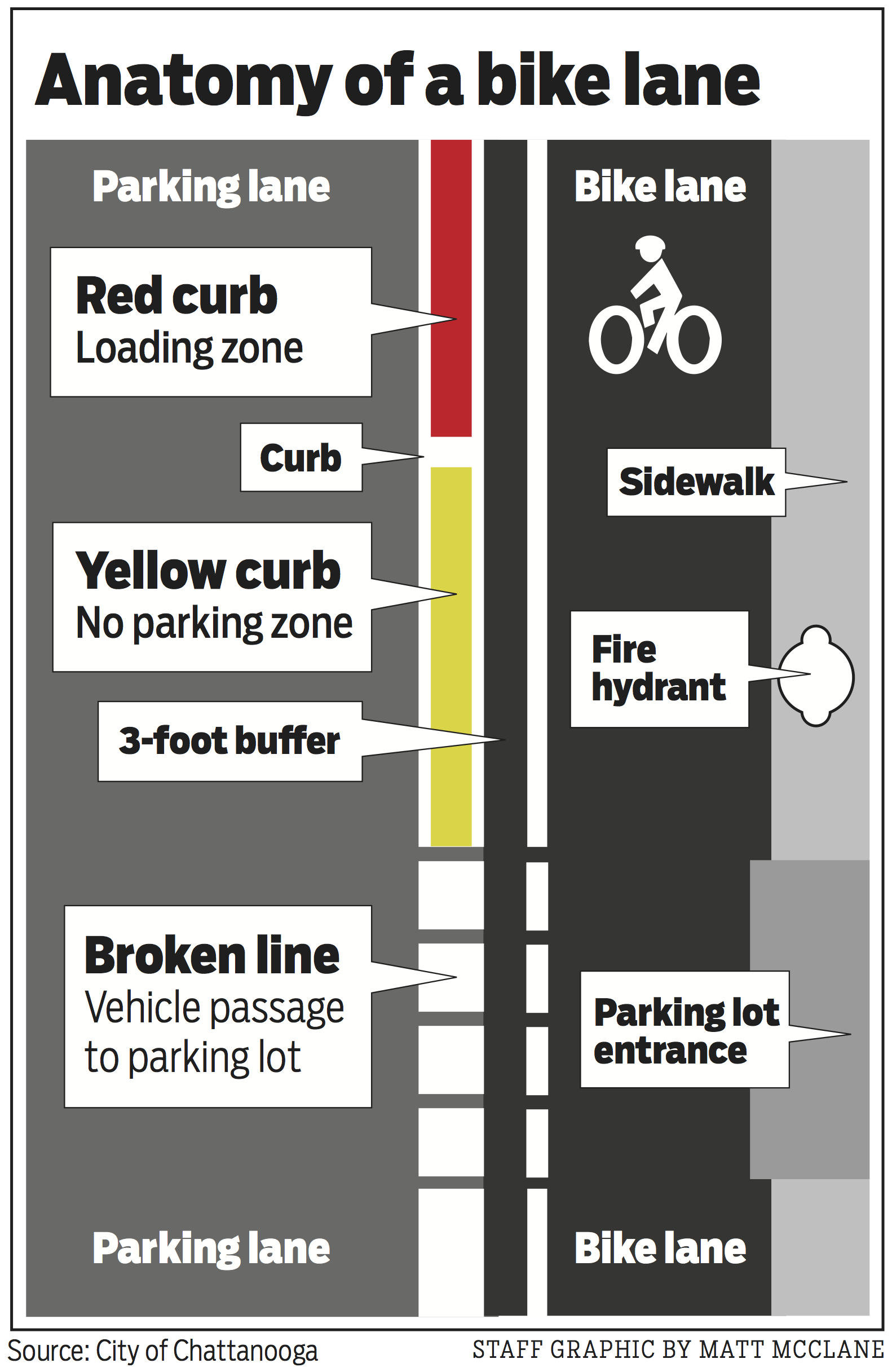Online
Sign up for city-issued updates on the project at http://connect.chattanooga.gov/mlkblvd/
Crash rates
East Martin Luther King Boulevard: 2.86 times the state averageBailey Avenue: 2.56 times the state averageFrom 2009-15 on Bailey-M.L. King, there was one pedestrian fatality, 10 pedestrian injuries, two pedestrian crashes without injury, four bike injuries and one bike crash
Quotes
Quotes from a public comment survey included in CDOT’s final report recommending the completion of the project. The names of the responders were not included in the report:› “Slower traffic is better for businesses on MLK and better safety for everyone!”› “My husband and I live on Bailey and could easily bike to work, but right now traffic is too fast to make us comfortable with biking.”› “I’d pay more for a house in an area with slower moving streets. This will do that, and will increase property values in my mind.”
As rush hour hummed steadily along just after 5 p.m. on a recent weekday at M.L. King Boulevard and Douglas Street, students from the University of Tennessee at Chattanooga faced a decision.
Some of them chose to wait patiently and cross the boulevard once the traffic signals changed to "walk."
Others chose to look both ways and make a run for it between the waves of passing cars as they headed to the new Douglas Heights apartment building or a dinner destination.
By next year, crossing the street on foot - whether legally or jaywalking - should feel a little bit less harrowing.
The Chattanooga Department of Transportation finalized a report last week that recommends a road right-sizing be conducted on the street, reducing it from four lanes to three with the addition of bike lanes.
Work is expected to begin on the project this spring.
It's a concept that was considered but abandoned for bustling Frazier Avenue earlier this year amid skepticism from area stakeholders over the project's benefits.
But along the 2.5-mile corridor of M.L. King Boulevard and Bailey Avenue where this proposal will be implemented, merchants and residents have praised the project for its intended effect of slowing traffic and cultivating a more pedestrian and cyclist-friendly street.
"We're very excited about it," Hutton & Smith Brewing Co. owner Melanie Krautstrunk said. "Slower traffic helps people notice your businesses. It also makes it a safer environment for pedestrians, so they don't feel like they're going to be injured crossing the street."
Hutton & Smith was one of six companies to send letters of support for the project to the Chattanooga Department of Transportation, according to the report.
City transportation director Blythe Bailey said stakeholder feedback played a "huge" role as CDOT officials considered whether to proceed with the proposal.
"I don't think I can overvalue the input from the business owners on MLK and the residents that are impacted the most," he said.
Still, some have expressed disapproval over the traffic delays that will result from the project and the potential increase of traffic on neighboring streets.
"One of the major concerns we heard in the survey, at meetings, and at events was the possibility for traffic congestion after right-sizing," the final report said.
An engineering analysis performed by Alta, the city's transportation design firm, showed that traffic will be delayed by 48 seconds at the intersection of East M.L. King and Central Avenue during peak afternoon commuting time.
At the intersection of Bailey and South Willow Street, drivers are expected to be delayed by 66 seconds during peak commuting hours.
The project's naysayers did not outweigh its proponents in a series of polls cited in the report, however.
Data provided by the city show 59.9 percent of the 573 people who responded to a public comment survey were in favor of reducing traffic to three lanes with the addition of bike lanes.
The survey, posted online from May 15 to Sept. 15, said 32.3 percent of responders want no change to the road. Another 7.7 percent favored a third option that would have reduced traffic to three wider lanes with no bike lanes.
The Chattanooga Department of Transportation also cited a Times Free Press poll that appeared in the online version of a September article about the proposal.
"Are bicycle lanes along M.L. King Boulevard a good idea?" the poll asked.
As of Monday, 50.2 percent of 303 responders said yes, while 49.2 percent said no.
Perhaps most influential, though, was the backing of businesses along the corridor, and the neighborhood associations in the M.L. King and Highland Park areas, which are both seeing some of their biggest new investment in years.
The Highland Park Neighborhood Association and Martin Luther King Neighborhood Association also sent letters of support for the proposal.
Douglas Heights is a new $41 million, 691-bed facility on M.L. King catering to UTC students. About a mile and a half to the east, after M.L. King turns into Bailey Avenue, Chattanooga Neighborhood Enterprise broke ground last month on Highland Park's largest investment in decades, a $4.7 million, 49-unit apartment building at the South Hawthorne Street intersection.
"The reality is that we also have some apartments coming up for persons who work in the downtown area," said City Councilman Yusuf Hakeem, who represents a portion of the affected stretch. "A number of them bicycle into town, and it makes it safer for them. In my view, they're the ones who will be directly impacted by it."
Controversy followed similar projects on Broad Street and North Market Street after the city accepted a 2014 federal grant that gave CDOT the power to begin implementing so-called road diet projects in accordance with a 2010 regional bicycle and pedestrian plan.
Hakeem said that, during those earlier proposals, he felt the city council was not appropriately informed on the transportation department's plans.
"But with this particular corridor that we're talking about, it appears there has been community involvement, community input for those areas that are right around that corridor," he said. "I feel like they're the ones who will be mostly impacted by either keeping traffic as it is or making the alteration."
Bailey said unrolling the project will be complicated, since it involves a mix of local, state and federal funding.
It also will have to be coordinated with the looming Miller Park renovations. He said CDOT officials plan to go door to door in the affected areas this winter to share information on what people can expect to see during the construction process.
"We're done with the input, but we're not done with the communication process," he said. "We're trying to coordinate everything, so we're really going to focus the next five months on doing the project as efficiently as possible with as little inconvenience as possible. That's our plan, is to deliver the project as smoothly as we can."
Contact staff writer David Cobb at dcobb@timesfreepress.com or 423-757-6249.


